 Researching Tristram Coffin comes quite easily as much has been written about him through out the history of the United States. Some of which is fact and some assumed so therefore you will find much conflicting information about him. He was one of the nine purchasers and founders of Nantucket Island and to him much credit is given. There are over 500 family trees on ancestry.com that connect to him so it could be said that he was also monumental in populating the United States from sea to shining sea.
Researching Tristram Coffin comes quite easily as much has been written about him through out the history of the United States. Some of which is fact and some assumed so therefore you will find much conflicting information about him. He was one of the nine purchasers and founders of Nantucket Island and to him much credit is given. There are over 500 family trees on ancestry.com that connect to him so it could be said that he was also monumental in populating the United States from sea to shining sea.
I am proud to say that he is my 9th great grandfather. Our Pierce line descends from his daughter Mary “Great Mary” Coffin Starbuck who was the wife of 8th great grandfather Nathaniel Starbuck, son of Edward and Katherine Reynolds Starbuck (also 9th great grandparents) of which I will write at a later date.
WHERE WE BEGIN
The first of the Coffin name of which there is any record is of Sir Richard Coffin who removed to Normandy, England in 1066 where he entered the English Army and had land granted to him and he was Knighted by the King. He was of Scandinavian decent like all Nobles of Normandy. The Vikings were settling in Normandy around the 800’s AD through conquest and they were granted the “Duchy of Normandy” by the French King “Charles the Simple” as a defense against other Viking Armies. The First “Duke of Normandy” was Hrolf or Rollo 911AD (an ancestor of “William the Conqueror”).
Sir Richard, as he was called, fought as a General for “William the Conqueror” (formally “William the Bastard”) at the Battle of Hastings, during the Norman invasion of England and Williams successful claim for the English Crown.
 We learn from Prince’s “Worthies of Devonshire” that the ancient family of the name settled at Portledge by the seaside in the Parish of Alwington, five miles from Biddeford and flourished there from the Conquest from the time of King Henry I to the age of King Edward the II. For two hundred years each successive heir of this family bore the name of Richard. (that’s a lot of Richards!)
We learn from Prince’s “Worthies of Devonshire” that the ancient family of the name settled at Portledge by the seaside in the Parish of Alwington, five miles from Biddeford and flourished there from the Conquest from the time of King Henry I to the age of King Edward the II. For two hundred years each successive heir of this family bore the name of Richard. (that’s a lot of Richards!)
Coffins are also in the Williams “Doomsday book” (1080) as current inhabitants of England, probably settlers from France at an earlier date. The Coffins spread out to Somerset, Dorset, Wiltshire and Cornwall. By 1252 the name in its different forms (Colvin, Corvin, Cophen and Coffyn) are frequently found in records. The name is disputed in its origins. Welsh “Coffyn” meaning hill top boundary, English and French: occupational name for a basket maker, from Old French cof(f)in ‘basket’ (Late Latin cophinus, Greek kophinos). The modern English word coffin is a specialized development of this term, not attested until the 16th century.
and the most likely is meaning of “Coffer” or treasure box.
A short distance from Fallaise, a town of Normandy, stands the old chateau of Courtition, the home of the Norman Coffin.
The last Miss Coffin married Le Clerc in the late 18th century and since that time Le Clerc family occupied the Norman estates.
WHAT ABOUT TRISTRAM
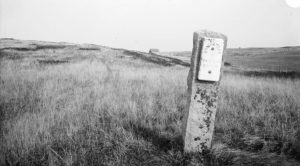 Tristram Coffin (Coffyn as was signed by him) was born to Peter and Joanna (Kember) Coffin (10th great grandparents)and baptized in the parish of Brixton near Plymouth, England, on 11 March 1609/10. He married Dionis Stevens in 1630 and they had nine children, the first five born in England. He was of the the landed gentry, or simply the gentry, which is a largely historical British social class consisting in theory of landowners who could live entirely from rental income, or at least had a country estate.
Tristram Coffin (Coffyn as was signed by him) was born to Peter and Joanna (Kember) Coffin (10th great grandparents)and baptized in the parish of Brixton near Plymouth, England, on 11 March 1609/10. He married Dionis Stevens in 1630 and they had nine children, the first five born in England. He was of the the landed gentry, or simply the gentry, which is a largely historical British social class consisting in theory of landowners who could live entirely from rental income, or at least had a country estate.
Charles I inherited the throne of England in 1625 and initiated a long struggle with his parliament, which wanted to abolish bishops from the House of Lords which is an upper house of Parliament, and limit the king’s powers. Things came to a head when Charles raised his royal standard at Nottingham in August 1642, and England soon descended into Civil War (1642–1651).
Tristram Coffin’s brother John received a mortal wound at Plymouth fort, although it is not known exactly when or which side he was fighting on. It could be for reasons associated with these political upheavals, Tristram Coffin decided to leave his estates in England and emigrate to the new America though some suggest that it was after the death of his father that he decided to remove.
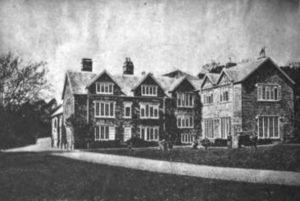
He bought with him his mother, and his sisters, Mary and Eunice, as well as his wife and the five children born in England.
Tristram immigrated to Massachusetts from England in 1642, and lived in Salisbury, Haverhill, and Newbury for sixteen years. For a short time he ran an inn in Salisbury, Massachusetts. He then moved to the new settlement of Pentucket, now Haverhill, Massachusetts. His children Mary Starbuck and John (the first John having died at the same place in 1642) were born at Salisbury. In 1648 he removed to Newbury, where his youngest son, Stephen was born. His name appears on a deed dated 15 November 1642 recording the sale of the land for the settlement by the local American Indian people.
He is said to have used a plow that he had made himself to cultivate the land. In 1648 he left the farm and moved to Newbury, Massachusetts and he operated a ferry across the Merrimack River . He and his wife Dionis ran a tavern in Newbury. In 1653 Dionis was “presented” for selling beer above the legal price of two pennies per quart but she was acquitted when it was found that her beer was much stronger than the ordinary. Coffin sold the inn and ferry in 1654 or 1655 and moved to Salisbury, Massachusetts, where he signed himself “Tristram Coffyn, Commissioner of Salisbury”.
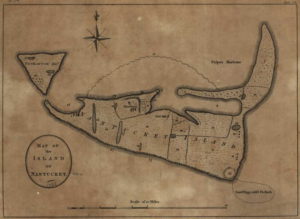
THE PURCHASE OF NANTUCKET
In 1659, he made a voyage of inquiry and observation to the group of islands off the Massachusetts coast, with a view to this change of residence. He first visited Matha’s Vineyeard, and taking from there Peter Folger as an interpreter of the Indian language, proceeded to Nantucket.
He along with Thomas Macy led a group of nine investors that bought Nantucket Island from Thomas Mayhew for thirty pounds and two beaver hats made by his son, Tristram JR . Coffin was among the prime movers of the enterprise and was given first choice of land. In 1659 he settled near the western end of the island near Capaum pond.It has been supposed that religious persecution was the cause of these frequent changes and of his final departure from the main land.
Soon after settling, Tristram Coffin purchased the thousand-acre Tuckernuck Island at the western end of Nantucket. On 10 May 1660 the sachems conveyed title to a large part of the island to Coffin and his associates for eighty pounds. He became one of the first prominent citizen of the settlement and was appointed the first chief magistrate of Nantucket on 29 June 1671 being the most respected and wealthy settler on the Island.
He built a corn mill in which he employed many of the local Native Americans, and he employed others on his farm.
In 1671 Coffin and Thomas Macy were selected as spokesmen for the settlers, going to New York to meet with Governor Francis Lovelace and secure their claim to Nantucket. In 1677 he was again appointed chief magistrate for a term of four years and it was said by Benjamin Franklin Folgers, the historian, that he always exhibited a fair Christian character “in all the varied circumstances and conditions of that infant colony,” both to Indians and white settlers.
TROUBLE AMONG THE COLONY
The first settlers had bought their rights to Nantucket with the intent of using the land for their own benefit. But, as more and more people came to Nantucket to live and work in the late seventeenth century, the newcomers began to resent their limited power and representation in the island’s government.
Led by ambitious newcomer John Gardner (a great uncle of the Pierce line), many of the “half-share men” staged a peaceful revolt against the proprietary government led by Tristram Coffin. Through several appeals to the provincial government in New York, the half-share men eventually succeeded in having the original proprietary transformed in favor of a more democratic, town-meeting-based government, where all men who held property had equal voting rights.
At first Tristram Coffin was the leading spirit politically and little was done without his approval and sanction. And he also had the backing of the Mayhews who still retain their interest. After John Gardner arrived in 1672, who was also of strong and forceful personality, there was trouble. He soon became prominent in the affairs of the Island and was appointed Captain of the Fort Company by Governor Lovelace. Tristram and John Gardner soon locked horns.
In 1673 the freeholders were required to name two men for Chief Magistrate and Edward Starbuck (9th great grandfather) and Richard Gardner (eighth greath grandfather) were submitted The governor chose the latter and named his brother Jim for Captain of the military company. This did not please the Coffins as it made their rivals hold two of the principal offices and so began the long fight whenever there was a meeting held .It was noted on the records, Mr. Tristram Coffin enters his dissent whereupon all the other members of his party followed suit but Tristram has been well called the great dissenter. The Coffins believed that the whole share men should have two votes and the half -share men one vote while the Gardners stood firm for equal power.
Each faction were soon appealing to the authorities in New York and the first round was won by the Coffins.
In 1674 the Gardner faction still being in control fined Stephen Hussey for contempt for telling Captain John to “meddle with his own business”.
In 1676 Thomas Macy, then Chief Magistrate and William Worth sided with the Coffins and they regained control of affairs. William Worth was chosen clerk and Gardner and Folger were arbitrarily disfranchised and refused any participation in the affairs of the town.
On Feb 10, 1677, Peter Folger was arrested for contempt of His Majesty’s authority. He was bound over for 20 pounds to appear in Court and in default was committed to jail where he remained in “durance vile coery vile” according to Peter for the greater part of a year.
Tobias COLEMAN,and Eleazer Folger and his wife Sarah..(Richard Gardner’s daughter) were arrested and fined for criticizing the Court.
Peter Folger refused to deliver up the Courts books. So things went on till August 1677 when Governor Androstook took a stand and ordered a suspension of all further proceedings and later decided that Gardner and Folger’s disfranchisement was null and void.
Mayhew and Coffin were furious but Captain Gardner had won and the hatchet was soon after buried.
Finally, in June of 1678, everyone gets tired of the in-fighting and a settlement is reached. The Full-Share men will allow other parts of the island to be bought from the Natives and developed while the half-share men agree that it will all involve the town.
Coffin and Gardner still hate each other, but everyone else is willing to live and let live.Then, in September of that year, Tristram Coffin finds himself in very hot water. A French ship wrecked itself on the shoals and Coffin had supervised the salvage operation. After all the gear was grabbed from the boat, it needed to be stored and guarded. Coffin botched the job and was brought before the Admiralty Court. Faced with possible jail time and a steep fine, Coffin appealed to John Gardener to help him.
Gardner weighed in on the Coffin side and Tristram was set free. One year later, Tristram died.Without Coffin, the compromise began in earnest. The half-share and full-share men began talking and working again. Moreover, the Natives were granted grazing rights for their own horses and all three parties were at peace.The final symbolic closure came in 1686 when Peter Coffin’s son Jethro married John Gardner’s daughter, Mary. John Gardner gave the new couple land for a new house and Peter Coffin supplied the lumber. They built, atop Sunset Hill, a house now known as the oldest house on Nantucket.
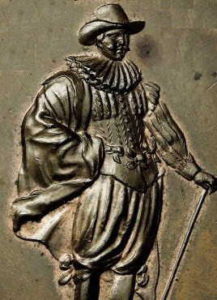
THE COFFIN FAMILY
He and his wife, Dionis, had five sons who perpetuated the Coffin family name. A great number of his descendants became prominent in North American society, and many were involved in the later history of Nantucket during and after its heyday as a whaling center, though when researching his history little is said about that part of his life.
Several Nantucket families, including the Coffins, Gardners, and the Starbucks (from all we decend), began whaling seriously in the 1690s, and by 1715, the Coffins owned three whalers and a trade vessel.
In 1642 there were only 455 people living in Newbury. The town’s economy was primarily a combination of agriculture and husbandry. There was a limited number of artisans and manufacturers. Some of the earliest were weavers, tanners, and shoemakers.
Tristram Coffin and his sons at one time owned about one-fourth of Nantucket, and the whole of the little island adjacent to it on the west, called Tuckermuck, containing 1,000 acres, which he purchased of the old Sachem Potonet at the time of his visit in 1659.
He appears to have been a leading spirit among the first settlers, and was frequently selected by the inhabitants to transact important public business. His letters to the Colonial Government of New York (Nantucket was at that time a dependency of New York), are preserved in the Archives of the Department of State at Albany.“At a Court of Sessions held the 29th of November 1681 there granted administration unto me James Coffin, John Coffin and Stephen Coffin on the estate of Mr. Tristram Coffin deceased the 3rd Oct 1681 they having given security according to law.”The body of the Oath was evidently written by Peter Coffin (son of Tristram), the signature is an autograph.
During the years before his death, he had bestowed much of his property on his children and grandchildren.
Tristram Coffin died on 2 October 1681 at the age of 76.He was buried on his property on Nantucket Island
At his death he left seven children, 60 grandchildren and several great-grandchildren.
Nearly all his descendants are enabled, by means of the accurate genealogical records in existence, to trace their linage back to him, although nearly two centuries have elapsed since his death.Almost all notable Americans with roots in Nantucket are descended from Tristram Coffin,
CHILDREN
Their daughter, Mary, married Nathaniel Starbuck and became known as “Great Mary” for her leadership in the early community and her conversion to Quakerism, looking to escape harsh Puritan rule in New England.
Peter,
Tristram,
Elizabeth,
James
John
Deborah
John
Stephen died on 1 Dec 1690 in Drowned off Cape Breton, Nova Scotia, Canada, at age 62 .
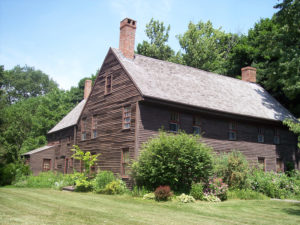 THE COFFIN HOUSE
THE COFFIN HOUSE
As the family grew, they added partitions and lean-tos so that different generations could continue to live together under one roof. In 1785 two Coffin brothers legally divided the structure into two separate dwellings, each with its own kitchen and living spaces. With rooms from the seventeenth, eighteenth, and nineteenth centuries, Coffin House depicts the impact of an expanding economy and new concepts, such as the notion of privacy, on architecture and modes of living.
The significance of Coffin House lies partly in the age of the original building but more importantly in the way in which it reveals how a home, built in 1678, grew and changed over the years to accommodate the needs of six generations of one family. The earliest part of the house, the southwest ell, is an example of what is known in New England as First Period or Post-Medieval style.When Tristram Coffin Jr. came to Newbury with his parents, siblings, aunts, and grandmother in 1643, it was a frontier settlement with Indian tribes nearby, wild animals, few roads, and most travel by water.
Most of the occupants of this house are buried across the street in the First Parish Burying Ground. Judith and Tristram JR. are buried on the left side of the burying ground if you are facing the front gate.
INTERESTING FACTS ON DECENDANTS
From Wikipedia we find this information on some of the Coffin descendants.
[6] His sons Peter Coffin, Tristram Coffin Junior and James Coffin also received land on the island.[13] [15][18] .[6] One of his grandchildren calculated that by the year 1728, the number of his descendants was 1582, of whom 1128 were still alive.
[19]Several of his descendants achieved prominence. His daughter Mary Coffyn Starbuck became a leader in introducing Quaker practices into Nantucket.
[20] A grandson, James Coffin, was the first of the Coffins to enter into the whaling business.
[21] A poem by Thomas Worth written in 1763 says six Captains named Coffin were sailing out of Nantucket.[3] Sir Isaac Coffin (1759–1839) served during the American Revolutionary War and the Napoleonic Wars and became an admiral in the British Royal Navy.[22] He founded a school on the island in 1827 to educate descendants of Tristram Coffin – which included almost all the children on the island – with emphasis on nautical skills.[23] Lucretia Coffin Mott (1793–1880) was a Quaker born on Nantucket, who became a prominent abolitionist and women’s rights activist. She helped write the Declaration of Sentiments during the Seneca Falls Convention in 1848, and will be included on the back of the U.S. $10 bill to be newly designed by 2020.
Some branches of the Coffin family were prominent in New England, grouped among the so-called Boston Brahmins.[24] For example, Elizabeth Coffin, daughter of a wealthy merchant from Nantucket, was mother of the prominent Massachusetts industrialists Henry Coffin Nevins and David Nevins Jr..
[25] Charles A. Coffin (1844–1926) born in Somerset, Massachusetts, became co-founder and first President of General Electric corporation.
[26] Some retained the family links to Nantucket after the whaling industry had collapsed and many people had left the island. In the eighth generation, Elizabeth Coffin (1850–1930), an artist, educator and Quaker philanthropist, was known for her paintings of Nantucket and for helping revive Sir Isaac Coffin’s school with a new emphasis on crafts.
[27] Among the ninth generation, Robert P. T. Coffin (1892–1955) was an American poet who won the Pulitzer Prize in 1936 for his book of collected poems called Strange Holiness.
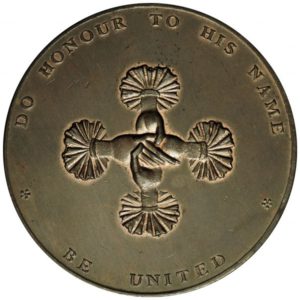
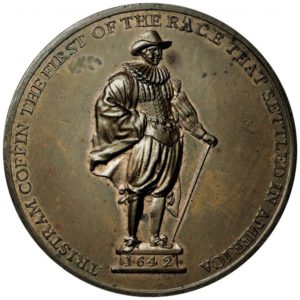
THE MEDALS
After the original struck medals were produced in 1826, the medal was cast and recast for family reunions on Nantucket, perhaps even as late as the first few decades of the 20th century.In the year 1826, Sir Isaac Coffin, a native of Boston (who went to England in early life and became a Baronet, and an Admiral in the British Navy), visited Nantucket and founded the ‘Coffin School’, which is still flourishing.
The Act of Incorporation provides for the establishment of a school by the name of Admiral Sir Isaac Coffin’s Lancasterian School, for the purpose of promoting decency, good order and morality, and for giving a good English education to youth who are descendants of the late Tristram Coffin who emigrated from England” etc. The act further provided that the Trustees shall all be the descendants of the above mention Tristram Coffin in the male or female line.
If you are interested in more history of the Starbuck, Macy, Coffin, Gardner line some great reads are
North American Family Histories
A genealogical History of Clark and Worth Families and other Puritain Settler in MA Bay Colony
Macy Genealogy
Life of Tristram Coffin
Netherlands Genealogy Online
Colonial Families of the USA
The Great Migration Begins
Encyclopedia of American Biographies
As Always thanks for stopping in. Hope you are enjoying our family history…and please leave a comment below! I love hearing from you!
THE PIERCE FAMILY HISTORIAN
happy hunting
.

Brian Donley and or Susan Holmes,
Tristram Coffin is my direct great grandfather. Levi Coffin is my direct grandfather also. I would absolutely die to own any family items! Please let me know if you still have them or what became of them. Pictures of pictures would even be treasured! Sadly, I have nothing from our family. Thank you so very much! Sashin
I think this was a scam.. they wanted 500 dollars for shipping!!! I don’t think I would chance it!
Tristam Coffin is one of my GGGGGFs.
(Hook-Swain) lines in Chichester, NH- have direct linkage at home on flash drive.
I’ll have to look closer at that. Nice to meet you cousin! Do come back and stay in touch.
Very nice article about the Coffins.
I’m a 11th generation Coffin descended from:
Tristram (wife Dionis)
Tristram Jr.
Peter
Tristram
Peter III
Tristram
John Wharf
Harvey Mackey
Sumner
Russell
me
It’s fun and interesting to see research about my family. Thank you for putting in the time to do this.
best regards,
Ronald S. Coffin
Well HeLLO COUSIN! So nice to meet you. Thanks you for the compliment and thank you for sharing your lineage! I will add it to my tree!
your brother is Richard born in 1931?
I actually descend from 3 of Tristram’s children, Mary, Steven, John. So I will show you the John line: Tristram –> John –> Samuel –> William –> Barnabas –> Abel –> Abigail –> Susan White –> Isaac Beard –> Ethel Beard –> John Hartley –> Sue Hartley —
> me
I too am from a long line of Coffin, Folger, Starbuck’s, all the way down to my 2GGM, Mary Starbuck Folger. We have a community set up on FB, if anyone would like to check out: Folger Family From Nantucket and Beyond. It isn’t exclusive to descendants of Peter Folger, since we are all so interrelated and we have some serious scholars (Ben Franklin / Folgers) and genealogists all gathered to help work these interesting lines. Wishing all my cousins a happy holiday!
I will have to check out that group. Nice to meet you cousin. Yes the Island of Nantucket has a lot of cousins descended from it doesn’t it.
Direct from Tristram,James
Nice to meet you cousin! I do love meeting cousins…close or distant!
Hello Cousin Susan,
I am Ralph LaFayette Evans III, a direct descendant of Tristram Coffin through his eighth child LT. John Coffin. My G. grandfather, Isaac Lafayette Evans, married my G. grandmother, Lucy Florence Reagan who was the daughter of Laura Jane Elizabeth Coffin. I found a pamplet in the Charleston, SC, city library about the 200th anniversary of the death of Tristram Coffin held on Nantucket Island, August 16 through 18, 1881. The family was hoping to raise between eight to ten thosand dollars at that time to erect bronze statues of Tristram and Dionis Coffin. Do you know if that happened? Do you have any of the Photographic copies that were made in 1881 of the oil paintings that were done during the fifteenth and sixteenth centuries of the descendants of the first Richard Coffin? These oil paintings are said to be hanging in Portledge, near Bideford, Devon County, England.
No I am not aware of any paintings but would love to know more if you find more info on it. Thank you for sharing your lineage!. I’ll get it in my tree!
Ralph Evans again. Here is my line:
Tristram
Lt John
Samuel
William
Bethuel
Elisha
Clarkson
Laura Jane Coffin Reagan
Lucy Reagan Evans
Ralph I
Ralph II
me!
Greetings, Susan,
Found your post while searching for Coffin slave holdings on Nantucket. I obtained a copy of Mary Coffin Thurston’s will (6x great) from 1783 from Newport Rhode Island and am trying to correlate a manumit release signed by Hezekiah and Mary Coffin Starbuck signed in 1783 to Mary’s Nantucket inheritance from her mother. Mary Thurston was the granddaughter of Stephen Coffin and her father, Paul, drowned when she was four years old. Would you have any information on slaves that were used by the Coffins on Nantucket in the 1700s?
Also, I wanted to let you know that the Coffin chateau, Cortitout, in Normandy is near La Hoguette and it is about 4 miles SE (as the falcon flies) of William the Conqueror’s chateau in Fallaise.
Best Regards, Martha Gentry
no nothing on the slaves. I do try to keep track of the names if and when I run into them but I haven’t put much effort into the research. I believe I remember reading something about the drowning.
Hello. We are visiting Normandy next week. Do you have any more information or the address of the chateau?
My father, Harry Bigelow Coffin was very proud of his family tree. He made one for me where I am pictured with my brother, Stephen, when we were children. I named my first son, Christopher & my second son , Tristram. Ansley is my mother’s maiden name which I took legally in preference to my married name. Interesting as we are dependents of Peter & Tristram & the love of the written word persists along with our ocean activities & proximity. Tristram lives in Honolulu & I on the Big Island. I enjoyed reading about our lineage & having new information . Sending Aloha & inviting contact by way of email or text.
I’m descended from Tristram’s children, Mary Coffin, John Coffin and Stephen Coffin…yes I know pretty wild! One thing this article say is that Stephen died in 1690 but other trees say 1734. Anyone have an answer to this?
EVERYONE IS RELATED!! It’s so confusing sometimes. My records show 1690 but I make mistakes. Unless we have two Stephens and are confusing them. THAT does happen. Nice to meet you cousin. I’ll get you in the tree. I wonder if we connect at the Beards or Whites. These are hard lines for me. I have several families that come together and could be paternal or maternal and I find dna doesn’t help when researching these lines.
I am a Coffin descendant through his daughter Elizabeth who married a Greenleaf.
Tristam Coffin is my 9th grandfather as well according to AncestryDNA
Welcome to the family! I love meeting new cousins.
I sent a comment yesterday and made an error concerning Jessie Coffin;
She was my Paternal grandmother, not maternal . Tristram Coffyn was my 10th great-uncle.
Hi Mary I am too! My Family is the Dixon Family.
Descendent of Elizabeth Coffin and Stephen Greenleaf
Hi everyone, I’m an off shoot of the Gardner clan. Tristram Coffin is my 8th Great Grandfather. I believe it was Freeman Gardner that came to Canada, settling in Nova Scotia. My grand-father was George Hunter Gardner and he settled in the beautiful province of British Columbia.
It’s nice to be making contact with you all.
Jane Elizabeth (Pearson) Super
So nice to meet you cousin.
John Coffin was my 8th grandfather on my father’s side. Any more information about him I would like to know. I have some information already.
It’s a constant search isn’t it. I would love if you would share anything that you find also. Nice to meet you cousin.
My husband’s mother was born a Coffin, in Oklahoma. Her line is as follows: Charles-Lemuel-Elisha Folger Coffin – Albert – William–Benjamin -Nathaniel – James- Tristram. We named our son Tristram. I was unaware of the long family history when we wed in 1971, but now have a much loved copy of The Coffin Saga by Will Gardner. I personally love the older history of Sir Richard and William the Conqueror and the granting of Portledge Lodge.
Tristram Coffin is my 10th Great-grandfather through his son , James. I would be happy to send you charts showing just how I connect with him. Would you be able to provide me with a mailing address? I don’t really know how to transmit things through today’s methods.
Than you.
Rob Bolzendahl
Bountiful, UT
Oh yes I would love to get your charts. It would help me in my research. I will email you my address. Thank you so much and nice to meet you Robert.
I too am a direct descendant of Tristram- as well as Peter Folger, John Gardner and Thomas Macy. Apparently, intermarriage was a necessity on such a small island. My line matriculated to southwest Ohio just prior to the war of 1812. My 4th great grandfather, Davis Whippy was a whaling ship captain and either sold or had his ship confiscated as the war approached.
I enjoyed reading your site and learned quite a bit. Thank you!
Oh I’m so glad to meet you Chris. I’d love for you to share your lineage so I can get it in the tree. I especially love the stories. Can you tell me anything else about your grandfather? That makes us what quadruple cousins??? LOL I’m glad you enjoyed my site.
Thank you for all of this information in one place. It is very helpful and interesting. I too am a decendant and Tristra. Is my 10th GGrandfather. My family is also the Pearson family of Rowley and Newbury. My father was born and raised and is jow buried in Amesbury.
My lineage is;
Tristam
Deacon Tristam Jr
Lydia Coffin, married Moses Little
Moses Little Jr
Stephen Little
Mary Little, married Silas Pearson
John Pearson
Moses Kent Pearson
Joseph W. Pearson
John R Pearson
Richard A Pearson
Wendy Pearson (myself)
I have loved visiting and learning the deep history of the settlers in Salisbury and the Essex County area and the history of Nantucket.
Thank you again for your efforts. They are greatly appreciated. Next week my husband and myself are spending 2 weeks on the Cape and some of the time on Nantucket and Marthas Vineyard then back up to Essex County and home to Atlanta. I always love to stand where my ancestors stood. It is an honor to know the people who did so much so I can have what I have. We are the keepers of their stories.
I’m so glad you enjoyed it. Thank you for your lineage, If I don’t already have it it my tree I will add it. It’s so nice to get to know the cousins isn’t it? Oh I’m so jealous you get to go to Nantucket. I so want to go there. It’s in my bucket list. I agree with the standing where your ancestors did. I got very emotional when I was able to visit my ancestors home in Virginia. Nice to meet you cousin.
Thank you for this wonderful information. I’m curious if you might know anything about Plainfield Farm in Sconset. In the 80s my grandfather found a milk jug while digging which said “Henry coffin” and “Plainfield Farm”. We owned the land in Sconset and once when I was a little girl I saw the ghost of a young girl. I hope this doesn’t sound too crazy. Nantucket has a history of spirits and I’ve long wondered about this sighting. I’m curious if anyone knows of a young girl who may have lived or died on that property. Perhaps she was a Coffin. Thanks for any info you might have.
I have not heard of this. I am most interested. Perhaps it’s time that I do a little research on this subject and see what I might find!! Due to health problems I had to let my website lapse for a bit. But I’m back and ready to go. Let me see what I can find on this!! Nice to meet you cousin!